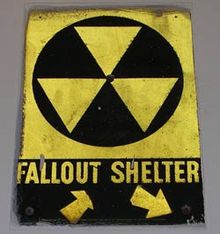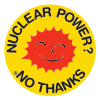
Back حركة مناهضة للأسلحة النووية في الولايات المتحدة Arabic Movimiento antinuclear en Estados Unidos Spanish Anti-nuclear movement in the United States SIMPLE

| Anti-nuclear movement |
|---|
 |
| By country |
| Lists |
The anti-nuclear movement in the United States consists of more than 80 anti-nuclear groups that oppose nuclear power, nuclear weapons, and/or uranium mining. These have included the Abalone Alliance, Clamshell Alliance, Committee for Nuclear Responsibility, Nevada Desert Experience, Nuclear Information and Resource Service, Physicians for Social Responsibility, Plowshares Movement, United Steelworkers of America (USWA) District 31, Women Strike for Peace, Nukewatch, and Women's International League for Peace and Freedom. Some fringe aspects of the anti-nuclear movement have delayed construction or halted commitments to build some new nuclear plants,[1] and have pressured the Nuclear Regulatory Commission to enforce and strengthen the safety regulations for nuclear power plants.[2] Most groups in the movement focus on nuclear weapons.
Anti-nuclear protests reached a peak in the 1970s and 1980s and grew out of the environmental movement.[3] Campaigns that captured national public attention involved the Calvert Cliffs Nuclear Power Plant, Seabrook Station Nuclear Power Plant (by the Clamshell Alliance), Diablo Canyon Power Plant, Shoreham Nuclear Power Plant, and Three Mile Island.[1]
Beginning in the 1980s, many anti-nuclear power activists began shifting their interest, by joining the rapidly growing Nuclear Freeze campaign, and the primary concern about nuclear hazards in the US changed from the problems of nuclear power plants to the prospects of nuclear war.[4] On June 3, 1981, the White House Peace Vigil began and has continued day and night ever since, thanks to William Thomas and a small band of stalwart antinuclear activists who launched the "Proposition One Campaign for a Nuclear-Free Future"[5] voter initiative in 1993 which led to a bill that has been introduced into the House of Representatives every session by Eleanor Holmes Norton. On June 12, 1982, one million people demonstrated in New York City's Central Park against nuclear weapons and for an end to the cold war arms race. It was the largest anti-nuclear protest and the largest political demonstration in American history.[6][7] International Day of Nuclear Disarmament protests were held on June 20, 1983, at 50 sites across the United States.[8][9] There were many Nevada Desert Experience protests and peace camps at the Nevada Test Site during the 1980s and 1990s.[10][11]
More recent campaigning by anti-nuclear groups has related to several nuclear power plants including the Enrico Fermi Nuclear Power Plant,[12][13] Indian Point Energy Center,[14] Oyster Creek Nuclear Generating Station,[15] Pilgrim Nuclear Generating Station,[16] Salem Nuclear Power Plant,[17] and Vermont Yankee Nuclear Power Plant.[18] There have also been campaigns relating to the Y-12 Nuclear Weapons Plant,[19] the Idaho National Laboratory,[20] Yucca Mountain nuclear waste repository proposal,[21] the Hanford Site, the Nevada Test Site,[22] Lawrence Livermore National Laboratory,[23] and transportation of nuclear waste from the Los Alamos National Laboratory.[24]
Some scientists and engineers have expressed safety concerns about specific nuclear power plants, including: Barry Commoner, S. David Freeman, John Gofman, Arnold Gundersen, Mark Z. Jacobson, Amory Lovins, Arjun Makhijani, Gregory Minor, M.V. Ramana, Joseph Romm and Benjamin K. Sovacool. Scientists who have opposed nuclear weapons include Paul M. Doty, Hermann Joseph Muller, Linus Pauling, Eugene Rabinowitch, M.V. Ramana and Frank N. von Hippel.
- ^ a b Giugni, Marco (2004). Social Protest and Policy Change: Ecology, Antinuclear, and Peace Movements p. 44.
- ^ Brown & Brutoco 1997, p. 198.
- ^ Kitschelt, Herbert P. (January 1986). "Political Opportunity Structures and Political Protest: Anti-Nuclear Movements in Four Democracies". British Journal of Political Science. 16 (1): 57–85. doi:10.1017/S000712340000380X. S2CID 154479502.
- ^ Lynch, Lisa (June 1, 2012). "'We Don't Wanna Be Radiated': Documentary Film and the Evolving Rhetoric of Nuclear Energy Activism" (PDF). American Literature. 84 (2): 327–351. doi:10.1215/00029831-1587368.
- ^ "Let's End the Whole Nuclear Era". Proposition 1 Campaign. Archived from the original on June 10, 2023.
- ^ Jonathan Schell. The Spirit of June 12 Archived May 12, 2019, at the Wayback Machine The Nation, July 2, 2007.
- ^ 1982 – a million people march in New York City Archived June 16, 2010, at the Wayback Machine
- ^ Cite error: The named reference
books.google.com.auwas invoked but never defined (see the help page). - ^ Cite error: The named reference
nl.newsbank.comwas invoked but never defined (see the help page). - ^ Cite error: The named reference
Lindsey1987was invoked but never defined (see the help page). - ^ Cite error: The named reference
New York Times 1992was invoked but never defined (see the help page). - ^ Slat, Charles. "Groups petition against new nuclear plant". Monroe News. Archived from the original on July 14, 2011. Retrieved March 16, 2009.
- ^ Fermi 3 opposition takes legal action to block new nuclear reactor Archived March 30, 2010, at the Wayback Machine
- ^ "Hudson River Lovers Fight to Shutter Aging Nuclear Power Plant". Bloomberg.com. Archived from the original on September 24, 2015. Retrieved March 5, 2017.
- ^ Oyster Creek's time is up, residents tell board Archived September 30, 2007, at the Wayback Machine Examiner, June 28, 2007.
- ^ Pilgrim Watch (undated). Pilgrim Watch
- ^ Unplugsalem.org (undated). UNPLUG Salem Archived September 27, 2008, at the Wayback Machine
- ^ Cite error: The named reference
elevenwas invoked but never defined (see the help page). - ^ Stop the Bombs! April 2010 Action Event at Y-12 Nuclear Weapons Complex Archived October 14, 2017, at the Wayback Machine,
- ^ Keep Yellowstone Nuclear Free (2003). Keep Yellowstone Nuclear Free Archived November 22, 2009, at the Wayback Machine
- ^ Sierra Club. (undated). Deadly Nuclear Waste Transport Archived March 8, 2005, at the Wayback Machine
- ^ 22 Arrested in Nuclear Protest The New York Times, August 10, 1989.
- ^ Hundreds Protest at Livermore Lab Archived January 17, 2013, at the Wayback Machine The TriValley Herald, August 11, 2003.
- ^ Concerned Citizens for Nuclear Safety (undated). About CCNS
© MMXXIII Rich X Search. We shall prevail. All rights reserved. Rich X Search